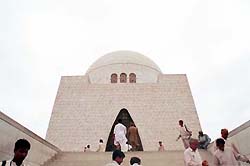| 4. Karachi
The Muslims living in India under British colonial rule sought the establishment of an “Islamic state,” contending the Hindus and Muslims are different nations. As a result, Pakistan came into being in 1947. In the new state, where a majority of residents were Muslims, it was hoped that the bonds of Islam would bring various ethnic groups closer and eventually lead to the creation of a “Pakistani nation.” Half a century after Partition, many chasms continue to run throughout Pakistan. These chasms are truly wide-ranging, from economic gap between the rich and the poor and politico-economic problems involving feuding between the authoritarian central government and opposing local governments, to the wide gap in values between urban elites, who often obtain academic degrees in major Western universities, and tribal people who live in the frontier provinces, as well as gender gaps in education and employment. Among these problems, the biggest involves ethnic and sectarian clashes that occur frequently in Karachi, a big city with a multiethnic population. Pakistan has managed to overcome a number of crises, thanks to people’s own efforts, massive assistance from Western countries, remittances from Pakistani migrant workers abroad, and increased food production through the “Green Revolution.” Since the 1980s, however, economic stagnation stemming from political instability and corruption, along with the rapid expansion of population, has cast a pall over the entire country. Pakistan today is far from the one envisioned by Muhammad Ali Jinnah, the country’s founding father. In Karachi, for example, rich people take showers with water delivered to their homes in trucks by private businesses, and regularly drink expensive mineral water purchased at bazzars. One might argue that the market mechanism is supplementing public services, but poor people do not benefit from this at all. Are the socially weak simply discarded? Aren’t there actors that present effective social safety nets, however small in scale, and who are capable of actually supporting these safety nets? Are the activities of Aga Khan simply exceptional examples that can be seen only in the northern frontier regions?
NEJIMA Susumu |
